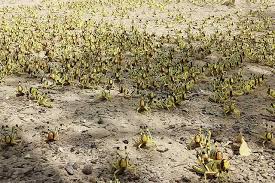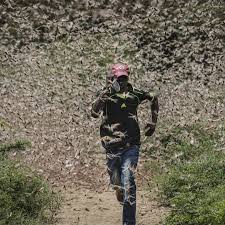Compiled by Zainab Ali
The forum for democratic change FDC party president Patrick Amuriat Oboi has expressed frustration with the sluggishness of the government in handling the locust invasion that has hit four districts of the Karamoja sub-region.
The FDC party president believes Uganda could be in a precarious state in the next few days depending on how fast the locusts move and how prepared the country is to deal with it.
Amuriat who made the remarks during a presser on Monday morning at the party headquarters in Najjanankumbi was concerned that since locusts are swift in their movement covering almost 1600km per day with devastating effects it may extend from Karamoja to Teso region in no time.
According to Amuriat, Uganda should have started planning the moment the locusts entered neighboring Kenya instead of holding an emergency meeting after the invasion.

On Sunday, the government confirmed an invasion of Desert Locusts in parts of Amudat, Nabilatuk, and Nakapiripirit in Karamoja sub-region that entered Uganda through the North West Pokot area on the border of Kenya.
Upon the announcement, Dr. Ruhakana Rugunda the prime minister held an emergency meeting with technocrats before declaring publicly that Uganda was ready and prepared to handle the fight against the desert locusts.
Dr. Rugunda has already paid approximately 11 billion Uganda Shillings, as a country’s contribution towards the Desert Locust Control Organisation for Eastern Africa (DLCO-EA)and the army was already on board with the fight.
Desert Locust Control Organisation is a regional organization for integrated pest and vector management that ensures food security in Eastern Africa Region.
Uganda is among the nine countries that form the body that including; Kenya, Tanzania, Ethiopia, Sudan, South Sudan, Eritrea, Somalia, and Djibouti.
Amuriat also demanded to know the level of preparedness in terms of how many aircraft are being used and the number of personnel that will be involved in the spraying exercise.
The FDC party president also questioned the safety of the pesticides being used considering they will be interfacing with water used by both humans domestic animals and wildlife. He was concerned about the immediate and long term effects the pesticides would have on all the above.

The government on Sunday listed three chemicals to use in the spray against the desert locusts. They include Fenitrothion, Malathion and Pyrethroid insecticides.
Stephen Tibeijuka Byantwale, the Commissioner of Crop Protection at the Ministry of Agriculture, Animal Industry and Fisheries, urged Ugandans not to worry about the chemicals being used as they are less harmful to human life since they have been used over time including in the neighboring country of Kenya since December.
He noted that the chemical being ariel sprayed is a special formulation with small amounts released at a calculated time to target the locusts and they are all environmentally acceptable.

He also noted that the government has been preparing for these locusts for the past two weeks and hopes they will contain them.
So far the government has sent 18,000 liters of chemicals to Amudat District in Karamoja sub-region, to aid the aerial spraying of locusts.on Sunday.
The chemicals were loaded and airlifted on Monday morning from Kololo airstrip, by the Ministry of Agriculture and Uganda Peoples Defence Forces-UPDF personnel to specifically in Okorikeya and Loro villages.

















